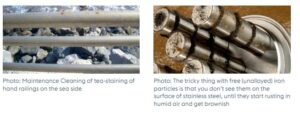An air- passivation of Stainless steels take place naturally on a clean surface. However in the presence of surface contamination, like free iron from contact with carbon steel tooling , this may interfere with the formation of the passive film. These contaminants has to be removed by using Passivator 601 to allow the oxygen uniform access to the surface in order to create the protective passive film. Further the air passivation may take too much time in some aggressive environments, like close to the sea side. The passive film build up may need assistance of the Passivator 601 to speed up the formation.
Avesta Passivator 601 contains nitric acid in accordance with ASTM A 967 for the Passivation of stainless steel by spraying, immersion or circulation. As an alternative for spray passivation we also recommend our acid-free Avesta FinishOne Passivator 630, to improve safety and minimize the environmental impact.
Provides a dual cleaning effect:
Avesta Passivator 601 is supplied in 25kg , and 1100kg IBC polyethylene packages. Availability of different packages sizes may differ between markets.
Avesta Passivator 601 should be stored indoors at room temperature. Containers must be kept properly closed, in an upright position and inaccessible to unauthorized persons.
To further enhance the results, we recommend applying passivation after pickling using Avesta FinishOne Passivator 630, which offers a safer, acid-free passivation method.
The waste water produced when passivating with Passivator 601 contains acids and should be treated with Avesta Neutraliser 502 or with slaked lime to a pH-value of 7-10 before discharge Empty containers (HDPE) must be cleaned and can then be recycled according to local regulations.
